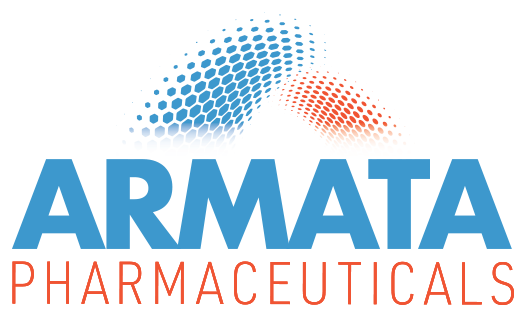Armata is committed to developing novel phage therapies that specifically address areas of high need. We have an acute bacterial infection clinical development plan focused on Staphylococcus aureus bacteremia, a difficult-to-treat and often life-threatening human infection that can result in high morbidity and mortality and for which bacterial resistance to antibiotics is growing.
AP-SA02
AP-SA02 is a novel biologic product candidate comprising natural lytic phages that target the problematic pathogen, Staphylococcus aureus, and offers robust therapeutic attributes, including:
- Potent antimicrobial activity against approximately 95% of S. aureus clinical isolates tested, including drug-resistant isolates (MRSA: methicillin-resistant S. aureus and VRSA: vancomycin-resistant S. aureus);
- Unique mechanism of action offers independent or synergistic benefit with standard of care antibiotics;
- Component phages are stable and retain infectivity after exposure to relevant biological fluids;
- Penetrates pre-existing S. aureus biofilms.
Clinical trial material of AP-SA02 is currently manufactured under cGMP at our production facility in California to support the required regulatory filing(s) for clinical studies in the U.S. and ex-U.S.
Clinical Development of AP-SA02: diSArm Study
The “diSArm” study (NCT05184764) is a Phase 1b/2a, multienter, randomized, double‐blind, placebo‐controlled, multiple ascending dose escalation study of the safety, tolerability, and efficacy of intravenous AP‐SA02 in addition to best available antibiotic therapy (BAT) compared to BAT alone (placebo) for the treatment of adults with complicated bacteremia due to Staphylococcus aureus. The study was conducted at sites in the United States and also at sites abroad in Australia.
The Phase 1b/2a study is partially funded by a $26.2 million award administered by the U.S Department of Defense through the Medical Technology Enterprise Consortium (MTEC) and managed by the Naval Medical Research Command (NMRC) – Naval Advanced Medical Development (NAMD) with funding from the Defense Health Agency and Joint Warfighter Medical Research Program.
In November 2024, we announced the completion of enrollment of the Phase 1b/2a diSArm study. Last patient last visit was completed in February 2025.
In May 2025, we announced positive topline results from the diSArm study:
Safety and efficacy were assessed in the intent-to-treat (ITT) population, which included all subjects (n=50) who received at least one dose of AP-SA02 or placebo.
AP-SA02, administered IV every six hours for five days, was well-tolerated, with no serious adverse events related to the study drug. Two subjects had adverse events that were possibly related to the study drug: one with transient liver enzyme elevation and one with hypersensitivity that resolved with discontinuation of vancomycin.
The primary clinical efficacy endpoint for the Phase 2a portion of the diSArm study was clinical outcome (responder rate) in subjects with complicated bacteremia, measured at (i) Test of Cure (“TOC”) for AP-SA02, defined as one week following the end of IV treatment with AP-SA02 (day 12), (ii) TOC for BAT, defined as one week following the end of IV BAT, and (iii) end of study (“EOS”), defined as four weeks following the end of IV BAT.
A statistically significant increase in investigator-assessed responder rate was observed at TOC for AP-SA02 (day 12) in AP-SA02 treated subjects (88%) versus placebo (58%) (p = 0.047). At TOC for BAT and at EOS, 100% of the AP-SA02 treated subjects had clinically responded (p = 0.017) versus 25% of placebo subjects considered non-responsive due to either relapse or treatment failure, consistent with the non-responder rate reported in the literature for recent phase 3 trials. Of note, the clinical response with AP-SA02 occurred regardless of whether subjects were infected with methicillin-sensitive S. aureus (“MSSA”) or methicillin-resistant S. aureus (“MRSA”). All subjects infected with MRSA and treated with AP-SA02 and BAT cleared their infection by TOC for BAT with no evidence of relapse through EOS, as compared to the relapse rate of BAT alone as noted above.
Supporting the investigator assessment, clinical outcome was assessed by the Clinical Efficacy Adjudication Committee, comprised of leading doctors in the bacteremia field, who agreed that subjects who received placebo had a 22% and 25% non-responder rate at TOC with BAT and at EOS, respectively, while 100% of the subjects who received AP-SA02 clinically responded (p = 0.025: TOC BAT; p = 0.020: EOS). Additionally, faster time to a negative blood culture and decline of key predictors of mortality and complications in SAB, including interleukin-10 and C-reactive protein, support the improved responder rates in subjects treated with AP-SA02.
Armata is committed to developing a pivotal S. aureus bacteremia trial to evaluate intravenousouly administered AP-SA02, as an adjunct to standard of care broad-spectrum antibiotics and/or potentially as an alternative to broad-spectrum antibiotics, which would decrease the utilization of broad-spectrum antibiotics and their detrimental impact on the healthy human microbiome.
Topline results from the Phase 1b/2a diSArm study can be found here.
Target Market and Medical Need
Bacteremia is a bacterial infection of the bloodstream. A common diagnosis, the Centers for Disease Control and Prevention (CDC) estimates that up to 1.7 million people in the U.S. develop bacteremia each year. S. aureus is the most commonly identified pathogen in both hospital- and community-acquired blood stream infections. Annually in the U.S. there are more than 150,000 hospitalizations for S. aureus bacteremia (SAB). Despite conventional antibiotics, mortality in SAB results in death of up to 40% of all cases and 57% of patients over the age of 85. Patients with comorbidities such as alcoholism, malignancy, diabetes, end-stage renal disease requiring hemodialysis, and immunosuppression are at even higher risk for death when SAB develops. Age-adjusted mortality assessments show that SAB mortality is higher than that of AIDS, tuberculosis, or viral hepatitis, and comparable to mortality rates for breast or prostate cancer. Outcomes are even poorer for SAB due to methicillin-resistant S. aureus (MRSA), classified as a serious threat to global health by the CDC and a high priority threat by the World Health Organization, with higher rates of complications and increased mortality as compared to methicillin-susceptible S. aureus (MSSA). Average hospital costs to patients with nosocomial SAB ranges between $40,000 (MSSA) and $114,000 (MRSA). Treatment failures are common in SAB, with highest rates due to MRSA. These failures can be attributed in part to poor penetration of some tissues by antibiotics, slow onset of bactericidal effects, emerging resistance patterns, and biofilm formation. While biofilms can render traditional antibiotics ineffective, phages may have the ability to penetrate the biofilm allowing rapid and efficient infection of the host and amplification at the site of infection. Until the recent FDA approval of Zevtera (intravenously administered cephalosporin antibiotic), daptomycin (approved in 2005; based on clinical cure rates of <50%) and vancomycin were the only two antibiotics with label indications in the U.S. for the treatment of SAB, and the emergence of drug-resistant S. aureus isolates, including to these two standard of care drugs, represents a major threat in terms of increasing morbidity, mortality and health care utilization.
Additional Clinical Indications for AP-SA02
Improved patient outcomes are needed for other Staphylococcal infections, in settings such as prosthetic joint infections and wound infections, for which antimicrobial resistance is a growing concern. We believe AP-SA02 could also have a meaningful impact in these indications, particularly infections caused by methicillin-resistant S. aureus (MRSA). In August, 2022, the U.S. FDA cleared Armata’s Investigational New Drug (IND) application for AP-SA02 in a second indication, prosthetic joint infection (PJI).

